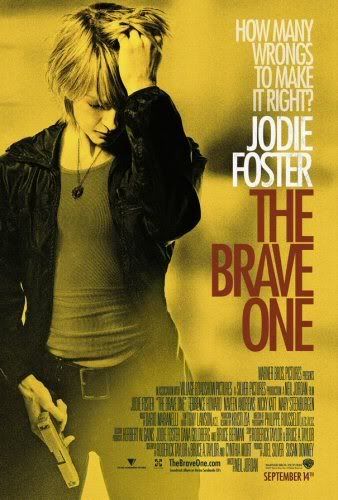 The Brave One suggests an addict who has yet to admit they have a problem. Although truly about a mentally fractured woman turned vigilante psychopath after a beating by thugs leaves her laid up in a hospital for three weeks, only to wake up to the news that her fiance was killed in the attack (all plot points readily pronounced in the previews, so don't cry spoiler), the film would like to pass itself off as a story about female empowerment—the kind of dunderhead regressiveness mistaken for social progress in a logic-free think tank. As it stands, it's a tepid concoction of morality lessons made easy via an overly literal sense of style-as-psychological-exploration; titular figure Erica Bain (Jodie Foster) understandably finds it difficult to venture outside her New York apartment after her devastating loss, but according to director Neil Jordan, the experience is one tantamount to wearing beer goggles on a weeble wobble. Gender violence kicks the bucket for a more general indulgence into shock-and-awe revenge fulfillment, the film purporting to criticize such eye-for-an-eye exchanges but doing such beliefs a disservice with its glamorizing aesthetic (no different than James Wan's equally vicious Death Sentence, but at least that film was honest about its nasty intentions). Foster—sexy and talented as ever—brings conviction to the contrived part (one example of her blah philosophies: "Now, I walk the streets at night. I find places that I never knew existed before. The question is, am I finding them, or are they finding me?"), though it is Terrence Howard who, as a detective striving to do good in a corrupt system, who provides the film with a much-needed emotional (and sober) epicenter. The Brave One's drawn-out morale—that change after an extreme loss is inevitable (the film never attempts to comment on New York post-9/11, though given its preexisting idiocies, it was probably better off)—can be considered in the bag after no less than the film's opening credits. If nothing else, enjoy Nicky Katt's hilariously smart-assed one-liners. As regards one of Bain's more deserving victims: "I'd say it was probably the fall that killed this guy... or it could be the crowbar embedded in his skull. I'd say it's about 50-50."
The Brave One suggests an addict who has yet to admit they have a problem. Although truly about a mentally fractured woman turned vigilante psychopath after a beating by thugs leaves her laid up in a hospital for three weeks, only to wake up to the news that her fiance was killed in the attack (all plot points readily pronounced in the previews, so don't cry spoiler), the film would like to pass itself off as a story about female empowerment—the kind of dunderhead regressiveness mistaken for social progress in a logic-free think tank. As it stands, it's a tepid concoction of morality lessons made easy via an overly literal sense of style-as-psychological-exploration; titular figure Erica Bain (Jodie Foster) understandably finds it difficult to venture outside her New York apartment after her devastating loss, but according to director Neil Jordan, the experience is one tantamount to wearing beer goggles on a weeble wobble. Gender violence kicks the bucket for a more general indulgence into shock-and-awe revenge fulfillment, the film purporting to criticize such eye-for-an-eye exchanges but doing such beliefs a disservice with its glamorizing aesthetic (no different than James Wan's equally vicious Death Sentence, but at least that film was honest about its nasty intentions). Foster—sexy and talented as ever—brings conviction to the contrived part (one example of her blah philosophies: "Now, I walk the streets at night. I find places that I never knew existed before. The question is, am I finding them, or are they finding me?"), though it is Terrence Howard who, as a detective striving to do good in a corrupt system, who provides the film with a much-needed emotional (and sober) epicenter. The Brave One's drawn-out morale—that change after an extreme loss is inevitable (the film never attempts to comment on New York post-9/11, though given its preexisting idiocies, it was probably better off)—can be considered in the bag after no less than the film's opening credits. If nothing else, enjoy Nicky Katt's hilariously smart-assed one-liners. As regards one of Bain's more deserving victims: "I'd say it was probably the fall that killed this guy... or it could be the crowbar embedded in his skull. I'd say it's about 50-50."Jan 31, 2008
The Brave One (2007): C
 The Brave One suggests an addict who has yet to admit they have a problem. Although truly about a mentally fractured woman turned vigilante psychopath after a beating by thugs leaves her laid up in a hospital for three weeks, only to wake up to the news that her fiance was killed in the attack (all plot points readily pronounced in the previews, so don't cry spoiler), the film would like to pass itself off as a story about female empowerment—the kind of dunderhead regressiveness mistaken for social progress in a logic-free think tank. As it stands, it's a tepid concoction of morality lessons made easy via an overly literal sense of style-as-psychological-exploration; titular figure Erica Bain (Jodie Foster) understandably finds it difficult to venture outside her New York apartment after her devastating loss, but according to director Neil Jordan, the experience is one tantamount to wearing beer goggles on a weeble wobble. Gender violence kicks the bucket for a more general indulgence into shock-and-awe revenge fulfillment, the film purporting to criticize such eye-for-an-eye exchanges but doing such beliefs a disservice with its glamorizing aesthetic (no different than James Wan's equally vicious Death Sentence, but at least that film was honest about its nasty intentions). Foster—sexy and talented as ever—brings conviction to the contrived part (one example of her blah philosophies: "Now, I walk the streets at night. I find places that I never knew existed before. The question is, am I finding them, or are they finding me?"), though it is Terrence Howard who, as a detective striving to do good in a corrupt system, who provides the film with a much-needed emotional (and sober) epicenter. The Brave One's drawn-out morale—that change after an extreme loss is inevitable (the film never attempts to comment on New York post-9/11, though given its preexisting idiocies, it was probably better off)—can be considered in the bag after no less than the film's opening credits. If nothing else, enjoy Nicky Katt's hilariously smart-assed one-liners. As regards one of Bain's more deserving victims: "I'd say it was probably the fall that killed this guy... or it could be the crowbar embedded in his skull. I'd say it's about 50-50."
The Brave One suggests an addict who has yet to admit they have a problem. Although truly about a mentally fractured woman turned vigilante psychopath after a beating by thugs leaves her laid up in a hospital for three weeks, only to wake up to the news that her fiance was killed in the attack (all plot points readily pronounced in the previews, so don't cry spoiler), the film would like to pass itself off as a story about female empowerment—the kind of dunderhead regressiveness mistaken for social progress in a logic-free think tank. As it stands, it's a tepid concoction of morality lessons made easy via an overly literal sense of style-as-psychological-exploration; titular figure Erica Bain (Jodie Foster) understandably finds it difficult to venture outside her New York apartment after her devastating loss, but according to director Neil Jordan, the experience is one tantamount to wearing beer goggles on a weeble wobble. Gender violence kicks the bucket for a more general indulgence into shock-and-awe revenge fulfillment, the film purporting to criticize such eye-for-an-eye exchanges but doing such beliefs a disservice with its glamorizing aesthetic (no different than James Wan's equally vicious Death Sentence, but at least that film was honest about its nasty intentions). Foster—sexy and talented as ever—brings conviction to the contrived part (one example of her blah philosophies: "Now, I walk the streets at night. I find places that I never knew existed before. The question is, am I finding them, or are they finding me?"), though it is Terrence Howard who, as a detective striving to do good in a corrupt system, who provides the film with a much-needed emotional (and sober) epicenter. The Brave One's drawn-out morale—that change after an extreme loss is inevitable (the film never attempts to comment on New York post-9/11, though given its preexisting idiocies, it was probably better off)—can be considered in the bag after no less than the film's opening credits. If nothing else, enjoy Nicky Katt's hilariously smart-assed one-liners. As regards one of Bain's more deserving victims: "I'd say it was probably the fall that killed this guy... or it could be the crowbar embedded in his skull. I'd say it's about 50-50."Jan 17, 2008
Saw III (2006): F
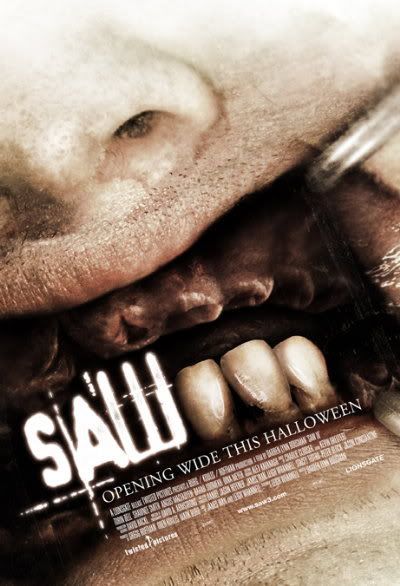 Sometimes less is more, and sometimes nothing seems damn near like a godsend. Such is the case with this rancid second sequel to 2004's surprise hit Saw, an affair of simultaneously astonishing boldness, unbelievable ineptitude, and blistering inhumanity - smug, stupid, and evil, respectively. As far as sequel amplifications go, Darren Lynn Bousman's second contribution to the series of flagellation is a been-there done-that affair, picking up where part two left off and continuing to complicate the previously established plot via a series of seemingly endless rewrites and increasingly histrionic plot twists, at once working overtime to justify itself as a necessary piece of the puzzle to the previous two films, while also desperately attempting to obscure the hidden-in-plain-view fact that this emperor never had any clothes to begin with. Jigsaw (Tobin Bell) is (finally) on his own deathbed, his body ransacked by cancer, and it is up to the newly kidnapped Dr. Lynn Denlon (Bahar Soomekh) to keep him alive long enough to bear witness his final "game", she fitted with an explosive collar linked to her captor's heart rate monitor, triggered to explode should the demented patient's heart flatline. Overly complicated plotting that need not be recounted here takes up the bulk of the film's running time, a series of indulgences that - like a prolonged sequence in which we see Jigsaw and his protege Amanda (Shawnee Smith) setting up the traps that encompassed the original film - prove interesting in the moment, if only for their glimmers of insight into the minds and motivations behind this overly orchestrated series of bloodlettings. These narrative cul-de-sacs, however, as well as several seemingly genuine examples of genuine emotional heft, ultimately prove nothing more than intentionally distracting time wasters, working both practically (so as to provide this unnecessary film with the status of feature length) and psychologically, ultimately positing the viewers themselves as the participants in the series' own elaborate and pointless death trap, the final scenes a case of cheap rug-pulling the likes of which this critic had never before seen. The Saw films' use of torture as the source of thrills has always been implicitly questionable (though, at least previously, never outright immoral thanks to their general silliness), but the gruesome games born witness to here - from a man nearly drown in liquefied pig remains, to a machine that unforgivingly twists the limbs of its occupant beyond their breaking point - succeed in making Mel Gibson's questionable Passion of the Christ exercises look like the work of Mother Theresa by comparison, offensive not so much in execution (sick though they are) but in the fact that they ultimately lead only to a dead-end "fuck you" to anyone reasonable enough to have an emotional response to them in the first place. By rewriting the events of both films prior, it goes without saying that this third entry reaches beyond its own breaking point of believability, not that its concerns lie anywhere other than smothering us in as much misanthropic cynicism as physically possible. Says Jigsaw during his final game: Face your fears. A lesson worthy of praise, if the film preaching them weren't so completely full of shit.
Sometimes less is more, and sometimes nothing seems damn near like a godsend. Such is the case with this rancid second sequel to 2004's surprise hit Saw, an affair of simultaneously astonishing boldness, unbelievable ineptitude, and blistering inhumanity - smug, stupid, and evil, respectively. As far as sequel amplifications go, Darren Lynn Bousman's second contribution to the series of flagellation is a been-there done-that affair, picking up where part two left off and continuing to complicate the previously established plot via a series of seemingly endless rewrites and increasingly histrionic plot twists, at once working overtime to justify itself as a necessary piece of the puzzle to the previous two films, while also desperately attempting to obscure the hidden-in-plain-view fact that this emperor never had any clothes to begin with. Jigsaw (Tobin Bell) is (finally) on his own deathbed, his body ransacked by cancer, and it is up to the newly kidnapped Dr. Lynn Denlon (Bahar Soomekh) to keep him alive long enough to bear witness his final "game", she fitted with an explosive collar linked to her captor's heart rate monitor, triggered to explode should the demented patient's heart flatline. Overly complicated plotting that need not be recounted here takes up the bulk of the film's running time, a series of indulgences that - like a prolonged sequence in which we see Jigsaw and his protege Amanda (Shawnee Smith) setting up the traps that encompassed the original film - prove interesting in the moment, if only for their glimmers of insight into the minds and motivations behind this overly orchestrated series of bloodlettings. These narrative cul-de-sacs, however, as well as several seemingly genuine examples of genuine emotional heft, ultimately prove nothing more than intentionally distracting time wasters, working both practically (so as to provide this unnecessary film with the status of feature length) and psychologically, ultimately positing the viewers themselves as the participants in the series' own elaborate and pointless death trap, the final scenes a case of cheap rug-pulling the likes of which this critic had never before seen. The Saw films' use of torture as the source of thrills has always been implicitly questionable (though, at least previously, never outright immoral thanks to their general silliness), but the gruesome games born witness to here - from a man nearly drown in liquefied pig remains, to a machine that unforgivingly twists the limbs of its occupant beyond their breaking point - succeed in making Mel Gibson's questionable Passion of the Christ exercises look like the work of Mother Theresa by comparison, offensive not so much in execution (sick though they are) but in the fact that they ultimately lead only to a dead-end "fuck you" to anyone reasonable enough to have an emotional response to them in the first place. By rewriting the events of both films prior, it goes without saying that this third entry reaches beyond its own breaking point of believability, not that its concerns lie anywhere other than smothering us in as much misanthropic cynicism as physically possible. Says Jigsaw during his final game: Face your fears. A lesson worthy of praise, if the film preaching them weren't so completely full of shit.
Saw II (2005): C-
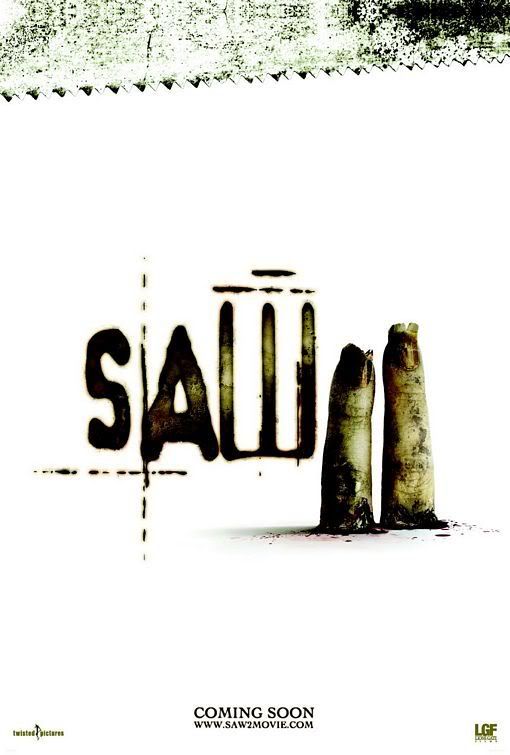 A film of absolutely zero great shakes, the original Saw holds a place of fondness in my heart strictly for the fact that it was the first I saw after John Kerry conceded defeat in the 2004 Presidential election; faced with the prospect of four more years with the newly
A film of absolutely zero great shakes, the original Saw holds a place of fondness in my heart strictly for the fact that it was the first I saw after John Kerry conceded defeat in the 2004 Presidential election; faced with the prospect of four more years with the newly Jan 16, 2008
A Nightmare on Elm Street Part 2: Freddy's Revenge (1985): B-
 Amidst the frenzy around Brokeback Mountain, HellBent was hailed by many as the first gay slasher film. Though hardly unworthy of its accrued praise, a film more worthy of the title is the 1985 sequel to A Nightmare on Elm Street, subtitled Freddy's Revenge. Sleep remains the primary source of terror as Krueger returns to haunt the dreams of the Elm Street children - the offspring of the townsfolk who burned him alive years ago, in turn for his own murderous acts - this time haunting the young Jesse Walsh (Mark Patton), who nighttime terrors and subsequent depression/alienation strike his conservative father as little more than cause for good old-fashioned physical reprimanding. Krueger finds in Jesse a unique physical surrogate, able to manipulate the teenagers body so as to kill people in waking life and with anonymity to boot; in a standout sequence, Jesse overcomes Krueger's grip as the villain purports to murder the protagonist's young sister. While a cutesy relationship with classmate Lisa Webbers (Kim Myers, essentially a more fuckable Meryl Streep) echoes the charming innocence of the eras work by John Hughes, this surprisingly inventive sequel quickly and silently transforms into an effective allegory for gay rights amidst the 80's AIDS crisis, with Walsh's lascivious, sweat-covered form subjected to the violent/sexual transformations of his beastly host, his internal conflicts misunderstood and denied relief by the external status quo. Krueger himself remains almost exclusively a background figure, less terrifying in the flesh than as a psychological presence to be struggled with, the surrealist visions of his nightmare death traps not unlike the physical manifestation of his primary target's adolescent hang-ups. These qualities are limited, however, in that they are by and large mere compliments to the otherwise traditional narrative form at hand rather than subversions of such. Although Jesse and Lisa are granted some much-needed time to get it on, he and the film would appear in unison in that they're still waiting to come out of the closet.
Amidst the frenzy around Brokeback Mountain, HellBent was hailed by many as the first gay slasher film. Though hardly unworthy of its accrued praise, a film more worthy of the title is the 1985 sequel to A Nightmare on Elm Street, subtitled Freddy's Revenge. Sleep remains the primary source of terror as Krueger returns to haunt the dreams of the Elm Street children - the offspring of the townsfolk who burned him alive years ago, in turn for his own murderous acts - this time haunting the young Jesse Walsh (Mark Patton), who nighttime terrors and subsequent depression/alienation strike his conservative father as little more than cause for good old-fashioned physical reprimanding. Krueger finds in Jesse a unique physical surrogate, able to manipulate the teenagers body so as to kill people in waking life and with anonymity to boot; in a standout sequence, Jesse overcomes Krueger's grip as the villain purports to murder the protagonist's young sister. While a cutesy relationship with classmate Lisa Webbers (Kim Myers, essentially a more fuckable Meryl Streep) echoes the charming innocence of the eras work by John Hughes, this surprisingly inventive sequel quickly and silently transforms into an effective allegory for gay rights amidst the 80's AIDS crisis, with Walsh's lascivious, sweat-covered form subjected to the violent/sexual transformations of his beastly host, his internal conflicts misunderstood and denied relief by the external status quo. Krueger himself remains almost exclusively a background figure, less terrifying in the flesh than as a psychological presence to be struggled with, the surrealist visions of his nightmare death traps not unlike the physical manifestation of his primary target's adolescent hang-ups. These qualities are limited, however, in that they are by and large mere compliments to the otherwise traditional narrative form at hand rather than subversions of such. Although Jesse and Lisa are granted some much-needed time to get it on, he and the film would appear in unison in that they're still waiting to come out of the closet.
Friday the 13th: Part II (1981): C+
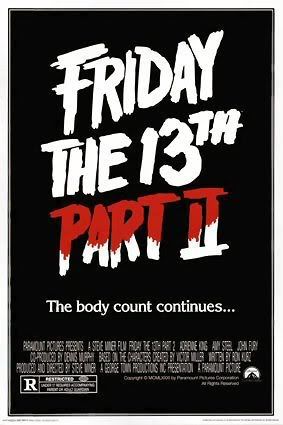 After the 1980 original, one might've been forgiven for thinking the Friday the 13th series had nowhere to go but up. Quality being relative, this is a fact that makes Part 2 appear better than it actually is, though its general competence remains a surprising improvement, albeit not one strong enough to elevate it far above its baser elements. Several years have passed since the slice-n-dice killing spree of the first film, enough time for the story of Jason Vorhees to take the form of local legend and his once-feared presence now regarded as little more than spooky superstition to scare kids into obedient submission. Camp Crystal Lake remains closed but nearby camping facilities have opened up to charitable (and sex-obsessed) teenagers, who go about their work hard, party hard ways, oblivious to the danger in their midst. Cheap voyeurism remains the defining trait of this follow-up, the camera an inconsistent "presence" used to evoke the perspective of a stalking killer as often as it is a producer of flimsy tension, the notion of charging the viewer as a responsible onlooker being far from this film's notions of cinematic possibilities. Jason proves a presence with a purpose, however, not yet hidden behind his culturally signifying hockey mask and thus allowed to act outside of such restrictive cultural tropes. Perhaps inadvertently, a sense of generational tension is evoked between the well-meaning campers and the local elders who know better; just as the teenagers drink and fuck to define themselves via separation from their parents, Jason kills in order to bring himself closer to his departed mother. The film's highlight doubles as a potential high-water mark for the entire series (an admittedly low standard), as Ginny Field (Amy Steel) attempts to sway Jason's murderous rage by impersonating the almost-inimitable Mrs. Vorhees. These moments of fascination, however, are not unlike loose parts flying around a junk drawer: potentially useful trinkets amidst a pile of garbage, too disjointed and incomplete to be of much use.
After the 1980 original, one might've been forgiven for thinking the Friday the 13th series had nowhere to go but up. Quality being relative, this is a fact that makes Part 2 appear better than it actually is, though its general competence remains a surprising improvement, albeit not one strong enough to elevate it far above its baser elements. Several years have passed since the slice-n-dice killing spree of the first film, enough time for the story of Jason Vorhees to take the form of local legend and his once-feared presence now regarded as little more than spooky superstition to scare kids into obedient submission. Camp Crystal Lake remains closed but nearby camping facilities have opened up to charitable (and sex-obsessed) teenagers, who go about their work hard, party hard ways, oblivious to the danger in their midst. Cheap voyeurism remains the defining trait of this follow-up, the camera an inconsistent "presence" used to evoke the perspective of a stalking killer as often as it is a producer of flimsy tension, the notion of charging the viewer as a responsible onlooker being far from this film's notions of cinematic possibilities. Jason proves a presence with a purpose, however, not yet hidden behind his culturally signifying hockey mask and thus allowed to act outside of such restrictive cultural tropes. Perhaps inadvertently, a sense of generational tension is evoked between the well-meaning campers and the local elders who know better; just as the teenagers drink and fuck to define themselves via separation from their parents, Jason kills in order to bring himself closer to his departed mother. The film's highlight doubles as a potential high-water mark for the entire series (an admittedly low standard), as Ginny Field (Amy Steel) attempts to sway Jason's murderous rage by impersonating the almost-inimitable Mrs. Vorhees. These moments of fascination, however, are not unlike loose parts flying around a junk drawer: potentially useful trinkets amidst a pile of garbage, too disjointed and incomplete to be of much use.
Jan 11, 2008
10 Things I Learned from Jason X
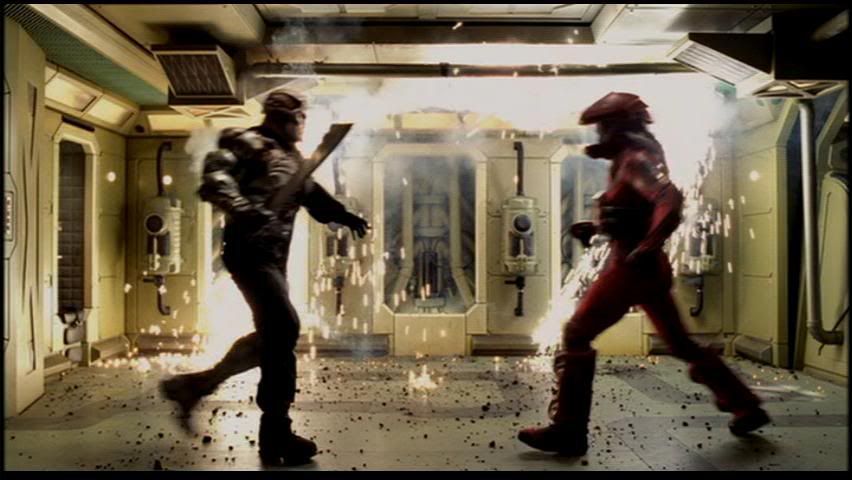
You never know where you'll find that next unexpected treasure trove; in my case, the most recent example being Jason X, a film I never expected to be enjoyable for a second and one whose many prequels I've never bothered with (save for the original). A brief summary of the plot: after authorities found it impossible to execute Jason Vorhees for his crimes, they opted the route of containment via cryogenic freezing. One poorly planned transfer and some 450 years later, Jason is now running amok on a futuristic spacecraft. Truly, the film is something of a marvel: bad by all traditional standards, but standing as something of a perfect distillation of schlocky 80's horror trends, with horrendous one-liners and cheap synthesizer scoring to boot. I kind of love it, in a McDonald's-ball-pit-version-of-Aliens sort of way. I'm now intrigued enough to go back and watch all those horror sequels of past -- who knows what else may be out there amongst the dreck? One hopes that Jason X will become an underdog classic of camp, what with its shameless death scenes and ridiculous climax, which essentially transforms from Jason X to Jason vs. Pris to Pris vs. The Black Knight to Uber Jason vs. Dave Bowman (the latter of which, apparently, has the power to defy gravity so as to attack from otherwise impossible right angles). Furthermore, the film proves bountiful in alerting us to what the future holds for mankind. Ten lessons to be taken from this film:
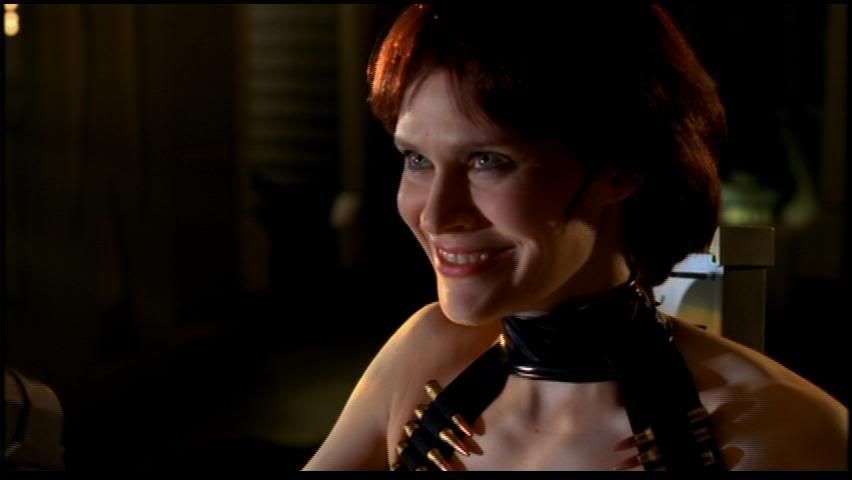
Now who's had that fantasy, huh?
Rating: B+
Subscribe to:
Comments (Atom)
